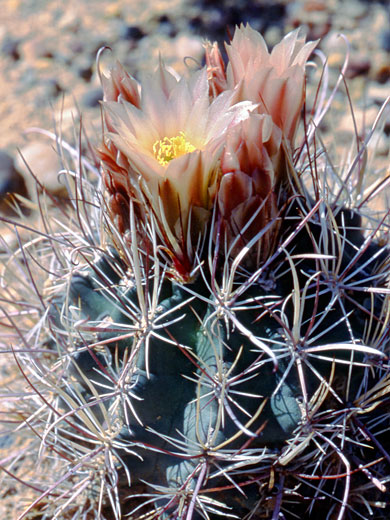Scientific name:
Sclerocactus sileri
Common name:
Siler fishhook cactus, House Rock fishhook cactus
Range:
Northern Coconino County, Arizona
Form:
Globes or small cylinders, usually unbranched
Habitat:
Clayish or sandy places, often gravelly; grassland and pinyon-juniper woodland
Flowers:
Pale yellow, creamy or pale brown; appearing in late April and early May

Distribution map for sclerocactus sileri
One common name for sclerocactus sileri, House Rock fishhook cactus, references the most likely location it can be found - House Rock Valley in northern Arizona. The species inhabits a small area, extending a little way east across the foothills of the Vermilion Cliffs, in a narrow elevation range between 5,200 and 5,900 feet. It is associated with gamma grass, sagebrush, yucca and pinyon-juniper woodland.
Stems are fairly small, up to 3.5 inches tall and 2 inches across, generally with 13 weakly developed ribs. There are usually six to eight radial spines per areole, slightly flattened, around half an inch in length, and four to six central spines; one or two angled upwards, and strongly hooked, two at either side, unhooked, and one or two pointing downwards, also unhooked but strongly flattened. All the central spines are longer than the radials, up to 1.5 inches.
Flowers are around 1.3 inches across, narrowly funnel-shaped, with broad purple stripes along the undersides of the outer tepals, otherwise pale yellow or cream in color. Tepals taper to a sharp point. Filaments are whitish, anthers yellow, and stigma lobes yellow. The style is densely covered with tiny bumps. Fruits split along vertical lines, two to four, a feature that distinguishes this species from others in the region.
Sclerocactus sileri has in the past been confused with pediocactus sileri, but the two are quite distinct species.
Stems are fairly small, up to 3.5 inches tall and 2 inches across, generally with 13 weakly developed ribs. There are usually six to eight radial spines per areole, slightly flattened, around half an inch in length, and four to six central spines; one or two angled upwards, and strongly hooked, two at either side, unhooked, and one or two pointing downwards, also unhooked but strongly flattened. All the central spines are longer than the radials, up to 1.5 inches.
Flowers are around 1.3 inches across, narrowly funnel-shaped, with broad purple stripes along the undersides of the outer tepals, otherwise pale yellow or cream in color. Tepals taper to a sharp point. Filaments are whitish, anthers yellow, and stigma lobes yellow. The style is densely covered with tiny bumps. Fruits split along vertical lines, two to four, a feature that distinguishes this species from others in the region.
Sclerocactus sileri has in the past been confused with pediocactus sileri, but the two are quite distinct species.
All Contents © Copyright The American Southwest | Comments and Questions | Contribute | Affiliate Marketing Disclosure | Site Map



